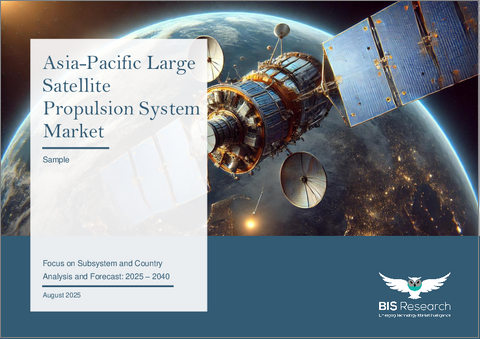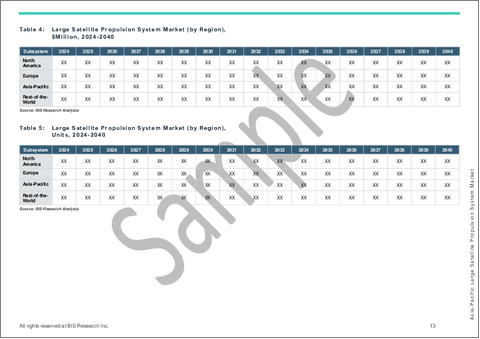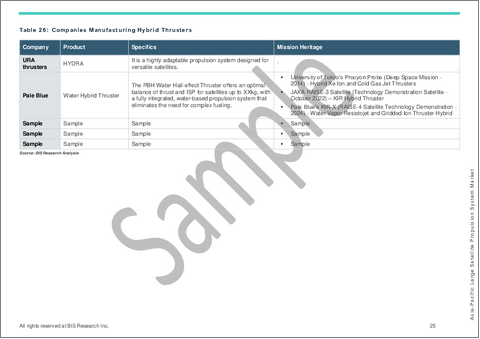|
|
市場調査レポート
商品コード
1800750
アジア太平洋の大型衛星推進システム市場:サブシステム別、地域別 - 分析と予測(2025年~2040年)Asia-Pacific Large Satellite Propulsion System Market: Focus on Subsystem and Country - Analysis and Forecast, 2025-2040 |
||||||
カスタマイズ可能
|
|||||||
| アジア太平洋の大型衛星推進システム市場:サブシステム別、地域別 - 分析と予測(2025年~2040年) |
|
出版日: 2025年08月30日
発行: BIS Research
ページ情報: 英文 74 Pages
納期: 1~5営業日
|
全表示
- 概要
- 図表
- 目次
アジア太平洋の大型衛星推進システムの市場規模は、2040年までに3,370万米ドルに達すると予測されています。
アジア太平洋の大型衛星推進システム市場は、化学、電気、コールドガス、ハイブリッドスラスタなど、幅広い宇宙推進技術を包含しており、いずれも重量級衛星の軌道投入、ステーション維持、終末マヌーバに不可欠なものです。同地域では、高スループットの通信衛星、高度な地球観測プラットフォーム、上昇する航法コンステレーション(いずれも正確な軌道上昇と長時間のステーション・キープ能力を必要とする)の利用が増加しており、これが需要を牽引しています。高推力の電気ホール効果スラスタ、環境に優しい化学推進、モジュール式ハイブリッド・ステージは、アジアの宇宙事業者に拡張性があり、手頃な価格で持続可能な選択肢を提供するために、ますます受け入れられている技術革新の一例です。市場は競争的であり、新規の地域メーカーも、ISRO、JAXA、CNSAのようなアジア太平洋の組織と協力している国際企業もあります。推進剤の効率性、軌道上のデブリの軽減、ミッションの柔軟性が重視されるようになり、調達戦術も変化しています。このため、再利用可能な推進システムや次世代電気推進への投資が促進されています。したがって、アジア太平洋の大型衛星推進市場は、技術の進歩、民間セクターの関与の増加、および現代の宇宙ミッションの性能要件の増加により、急速に変化しています。
市場導入
アジア太平洋の大型衛星推進システム市場の力強い成長には、政府宇宙プロジェクトの増加、商業衛星の試み、最先端の宇宙モビリティ技術への投資の増加がすべて寄与しています。重量衛星の軌道投入、ステーション・キープ、姿勢制御、寿命末期のマヌーバはすべて、化学、電気、コールドガス、ハイブリッド技術を含む推進システムに依存しています。
高スループットの通信衛星、高度な地球観測プラットフォーム、拡大する航法衛星群の配備はすべて、アジア太平洋における需要の加速に寄与しています。中国、インド、日本などの国々は、各国の宇宙機関の支援の下、野心的なミッションを主要企業として推進しており、一方、非公開会社は地域の研究開発・製造能力をますます強化しています。
この地域の技術動向には、環境に優しい化学エンジン、モジュール式ハイブリッド設計、ホール効果スラスターのような高効率電気推進装置の使用が含まれ、これらは拡張可能で手頃なソリューションを提供します。地域の生産者と国際的な航空宇宙産業の専門家とのコラボレーションは、情報共有を促進し、ミッションの適応性、デブリの削減、推進剤の効率性における進歩を推進しています。
アジア太平洋の宇宙産業がより大きな星座とより長いミッション寿命へとシフトするにつれて、高性能で持続可能な推進設計に対するニーズは大幅に高まると予想されます。このダイナミックな市場は、新技術、革新的なパートナーシップ、現代の宇宙ミッションの性能ニーズの高まりにより、現在も急速に変化しています。
市場セグメンテーション
セグメンテーションサブシステム別
- 化学スラスター
- 推進剤タンク
- ポンプ
- 燃料・酸化剤バルブ
- 電動スラスター
- 推進剤タンク
- ポンプ
- コールドガススラスター
- ガス貯蔵タンク
- 推進チャンバー/ノズル
- ポンプ
- ハイブリッドスラスター
- 推進剤タンク
- 推進室/ノズル
- ポンプ
セグメンテーション2:地域別
- アジア太平洋
アジア太平洋の大型衛星推進システムの市場動向と促進要因・課題
動向
- 通信、地球観測、ナビゲーションのための高度なペイロードを搭載した大型衛星の配備拡大
- 電気推進技術、特にホール効果スラスタ(HET)とグリッドイオンエンジン(GIE)の統合の増加
- 既存の航空宇宙会社とJAXA、ISROなどのアジア太平洋宇宙機関、新興の非公開会社とのコラボレーション
- 推進システムやAOCSサブシステムにおけるデジタル・モニタリングや自律制御の採用増加
- 遠隔地で低遅延ブロードバンド接続を提供するための大型衛星コンステレーションの役割拡大
促進要因
- 防衛および戦略的用途のための安全な衛星通信インフラ強化に向けた政府の強力なイニシアティブ
- アジア太平洋全域のデジタル格差を埋めるためのメガ衛星コンステレーションに対する需要の高まり
- 低燃費、低メンテナンスの推進技術への研究開発投資の増加
- 気候監視、災害管理、海上監視などの宇宙ベースのサービスの拡大
課題
- 厳しい規制と、大型コンステレーション別軌道上のスペースデブリへの懸念
- 推進サブシステムの開発と統合にかかる高いコストと複雑さ
- 低推力別軌道変換時間の延長など、電気推進の限界
- 環境・安全基準を満たすための、持続可能で無害な推進剤の必要性
製品/イノベーション戦略:製品タイプは、読者がアジア太平洋地域で入手可能なさまざまなタイプの製品を理解するのに役立ちます。さらに、推進サブシステムに基づく製品別の大型衛星推進システム市場の詳細な理解を読者に提供します。
アジア太平洋の大型衛星推進システム市場では、事業拡大、提携、協力、合弁など、市場で事業を展開する主要企業による主要な開拓が見られます。各社に好まれる戦略は、大型衛星推進システム市場における地位を強化するための相乗的な活動です。
目次
エグゼクティブサマリー
第1章 地域
- 大型衛星推進システム市場(地域別)
- アジア太平洋
第2章 スラスタと規制分析
- スラスターの分析(用途別)
- ハイブリッドスラスター
- コールドガススラスタ
- 化学スラスタ(高温ガスおよび温ガス)
- 電動スラスター
- アナリストの視点
- 規制分析(国別)
- インド
- 中国
第3章 重要な顧客情報
第4章 成長の機会と推奨事項
- 成長の機会
- 次世代スラスターポンプのための材料科学の進歩
- AI駆動型予知保全と効率最適化の統合
- 新興宇宙および商業ベンチャーにおける市場需要の拡大
- 宇宙用途向け持続可能で環境に優しいポンプソリューション
- 大型衛星軌道遷移・マヌーバ用太陽電気推進システムの開発
- 宇宙ベースの情報収集・監視・偵察(ISR)ソリューションに対する需要の高まり
第5章 調査手法
List of Figures
- Figure 1: Key Players in the Large Satellite Propulsion System Market
- Figure 2: Data Triangulation
- Figure 3: Assumptions and Limitations
List of Tables
- Table 1: Market Segmentations for Large Satellite Propulsion System Market
- Table 2: Key Regulations for Asia-Pacific Large Satellite Propulsion System Market
- Table 3: Key Opportunities for Large Satellite Propulsion System Market
- Table 4: Large Satellite Propulsion System Market (by Region), $Million, 2024-2040
- Table 5: Large Satellite Propulsion System Market (by Region), Units, 2024-2040
- Table 6: Asia-Pacific Large Satellite Propulsion System Market (by Subsystem), $Million, 2024-2040
- Table 7: Asia-Pacific Large Satellite Propulsion System Market (by Subsystem), Units, 2024-2040
- Table 8: Asia-Pacific Large Satellite Propulsion System Market (by Chemical Thruster), $Million, 2024-2040
- Table 9: Asia-Pacific Large Satellite Propulsion System Market (by Chemical Thruster), Units, 2024-2040
- Table 10: Asia-Pacific Large Satellite Propulsion System Market (by Electric Thruster), $Million, 2024-2040
- Table 11: Asia-Pacific Large Satellite Propulsion System Market (by Electric Thruster), Units, 2024-2040
- Table 12: Asia-Pacific Large Satellite Propulsion System Market (by Cold Gas Thruster), $Million, 2024-2040
- Table 13: Asia-Pacific Large Satellite Propulsion System Market (by Cold Gas Thruster), Units, 2024-2040
- Table 14: Asia-Pacific Large Satellite Propulsion System Market (by Hybrid Thruster), $Million, 2024-2040
- Table 15: Asia-Pacific Large Satellite Propulsion System Market (by Hybrid Thruster), Units, 2024-2040
- Table 16: China Large Satellite Propulsion System Market (by Subsystem), $Million, 2024-2040
- Table 17: China Large Satellite Propulsion System Market (by Subsystem), Units, 2024-2040
- Table 18: China Large Satellite Propulsion System Market (by Chemical Thruster), $Million, 2024-2040
- Table 19: China Large Satellite Propulsion System Market (by Chemical Thruster), Units, 2024-2040
- Table 20: China Large Satellite Propulsion System Market (by Electric Thruster), $Million, 2024-2040
- Table 21: China Large Satellite Propulsion System Market (by Electric Thruster), Units, 2024-2040
- Table 22: China Large Satellite Propulsion System Market (by Cold Gas Thruster), $Million, 2024-2040
- Table 23: China Large Satellite Propulsion System Market (by Cold Gas Thruster), Units, 2024-2040
- Table 24: China Large Satellite Propulsion System Market (by Hybrid Thruster), $Million, 2024-2040
- Table 25: China Large Satellite Propulsion System Market (by Hybrid Thruster), Units, 2024-2040
- Table 26: India Large Satellite Propulsion System Market (by Subsystem), $Million, 2024-2040
- Table 27: India Large Satellite Propulsion System Market (by Subsystem), Units, 2024-2040
- Table 28: India Large Satellite Propulsion System Market (by Chemical Thruster), $Million, 2024-2040
- Table 29: India Large Satellite Propulsion System Market (by Chemical Thruster), Units, 2024-2040
- Table 30: India Large Satellite Propulsion System Market (by Electric Thruster), $Million, 2024-2040
- Table 31: India Large Satellite Propulsion System Market (by Electric Thruster), Units, 2024-2040
- Table 32: India Large Satellite Propulsion System Market (by Cold Gas Thruster), $Million, 2024-2040
- Table 33: India Large Satellite Propulsion System Market (by Cold Gas Thruster), Units, 2024-2040
- Table 34: India Large Satellite Propulsion System Market (by Hybrid Thruster), $Million, 2024-2040
- Table 35: India Large Satellite Propulsion System Market (by Hybrid Thruster), Units, 2024-2040
- Table 36: Japan Large Satellite Propulsion System Market (by Subsystem), $Million, 2024-2040
- Table 37: Japan Large Satellite Propulsion System Market (by Subsystem), Units, 2024-2040
- Table 38: Japan Large Satellite Propulsion System Market (by Chemical Thruster), $Million, 2024-2040
- Table 39: Japan Large Satellite Propulsion System Market (by Chemical Thruster), Units, 2024-2040
- Table 40: Japan Large Satellite Propulsion System Market (by Electric Thruster), $Million, 2024-2040
- Table 41: Japan Large Satellite Propulsion System Market (by Electric Thruster), Units, 2024-2040
- Table 42: Japan Large Satellite Propulsion System Market (by Cold Gas Thruster), $Million, 2024-2040
- Table 43: Japan Large Satellite Propulsion System Market (by Cold Gas Thruster), Units, 2024-2040
- Table 44: Japan Large Satellite Propulsion System Market (by Hybrid Thruster), $Million, 2024-2040
- Table 45: Japan Large Satellite Propulsion System Market (by Hybrid Thruster), Units, 2024-2040
- Table 46: Rest-of-Asia-Pacific Large Satellite Propulsion System Market (by Subsystem), $Million, 2024-2040
- Table 47: Rest-of-Asia-Pacific Large Satellite Propulsion System Market (by Subsystem), Units, 2024-2040
- Table 48: Rest-of-Asia-Pacific Large Satellite Propulsion System Market (by Chemical Thruster), $Million, 2024-2040
- Table 49: Rest-of-Asia-Pacific Large Satellite Propulsion System Market (by Chemical Thruster), Units, 2024-2040
- Table 50: Rest-of-Asia-Pacific Large Satellite Propulsion System Market (by Electric Thruster), $Million, 2024-2040
- Table 51: Rest-of-Asia-Pacific Large Satellite Propulsion System Market (by Electric Thruster), Units, 2024-2040
- Table 52: Rest-of-Asia-Pacific Large Satellite Propulsion System Market (by Cold Gas Thruster), $Million, 2024-2040
- Table 53: Rest-of-Asia-Pacific Large Satellite Propulsion System Market (by Cold Gas Thruster), Units, 2024-2040
- Table 54: Rest-of-Asia-Pacific Large Satellite Propulsion System Market (by Hybrid Thruster), $Million, 2024-2040
- Table 55: Rest-of-Asia-Pacific Large Satellite Propulsion System Market (by Hybrid Thruster), Units, 2024-2040
- Table 56: Companies Manufacturing Hybrid Thrusters
- Table 57: Companies Manufacturing Cold Gas Thrusters
- Table 58: Companies Manufacturing Chemical Thrusters
- Table 59: Companies Manufacturing Electric Thrusters
- Table 60: List of Companies and their Key Customers for Thrusters
This report can be delivered in 2 working days.
Introduction to Asia-Pacific Large Satellite Propulsion System Market
The Asia-Pacific large satellite propulsion system market is projected to reach $33.7 million by 2040. The large satellite propulsion system market in Asia-Pacific encompasses a broad spectrum of in-space thrust technologies, such as chemical, electric, cold-gas, and hybrid thrusters, all of which are essential for heavyweight satellite orbit insertion, station-keeping, and end-of-life maneuvers. The region's increasing use of high-throughput communication satellites, sophisticated Earth observation platforms, and rising navigation constellations-all of which need accurate orbit-raising and long-duration station-keeping capabilities-is driving demand. High-thrust electric Hall-effect thrusters, environmentally friendly chemical propulsion, and modular hybrid stages are examples of technological innovations that are being embraced more and more to provide space operators in Asia with scalable, affordable, and sustainable options. The market is competitive, with both new regional manufacturers and international firms working with APAC organizations like ISRO, JAXA, and CNSA. Procurement tactics are changing due to a greater emphasis on propellant efficiency, orbital debris mitigation, and mission flexibility. This is driving investments in reusable propulsion systems and next-generation electric propulsion. The market for large satellite propulsion in Asia-Pacific is therefore changing quickly due to advancements in technology, more involvement from the private sector, and the increasing performance requirements of contemporary space missions.
Market Introduction
The growing government space projects, commercial satellite endeavors, and increasing investments in cutting-edge in-space mobility technologies are all contributing to the strong growth of the Asia-Pacific (APAC) big satellite propulsion system market. Heavyweight satellite orbit insertion, station-keeping, attitude control, and end-of-life maneuvers all depend on propulsion systems, which include chemical, electric, cold-gas, and hybrid technologies.
The deployment of high-throughput communication satellites, sophisticated Earth observation platforms, and expanding navigation constellations are all contributing to the acceleration of demand in APAC. Under the auspices of their national space agencies, nations like China, India, and Japan are leading ambitious missions, while private companies are increasingly bolstering regional R&D and manufacturing capacities.
The region's technological trends include the use of environmentally friendly chemical engines, modular hybrid designs, and high-efficiency electric propulsion like Hall-effect thrusters, which provide scalable and affordable solutions. Collaborations between regional producers and international aerospace industry experts are promoting information sharing and propelling advancements in mission adaptability, debris reduction, and propellant efficiency.
The need for high-performance, sustainable propulsion designs is anticipated to increase significantly as the APAC space industry shifts toward larger constellations and longer mission lifespans. This dynamic market is still changing quickly due to new technology, innovative partnerships, and the increasing performance needs of contemporary space missions.
Market Segmentation
Segmentation: By Subsystem
- Chemical Thruster
- Propellant Tank
- Pump
- Fuel and Oxidizer Valve
- Electric Thruster
- Propellant Tank
- Pump
- Cold Gas Thruster
- Gas Storage Tank
- Propulsion Chamber/Nozzle
- Pump
- Hybrid Thruster
- Propellant Tank
- Propulsion Chamber/Nozzle
- Pump
Segmentation 2: by Region
- Asia-Pacific
APAC Large Satellite Propulsion System Market Trends, Drivers and Challenges
Trends
- Growing deployment of large satellites with advanced payloads for telecommunications, Earth observation, and navigation.
- Increasing integration of electric propulsion technologies, particularly Hall-effect thrusters (HET) and gridded-ion engines (GIE).
- Collaboration between established aerospace companies and APAC space agencies like JAXA, ISRO, and emerging private players.
- Rising adoption of digital monitoring and autonomous control in propulsion and AOCS subsystems.
- Expanding role of large satellite constellations to provide low-latency broadband connectivity in remote regions.
Drivers
- Strong government initiatives to strengthen secure satellite communication infrastructure for defense and strategic applications.
- Rising demand for mega-constellations to bridge digital divides across APAC.
- Growing R&D investments in fuel-efficient, low-maintenance propulsion technologies.
- Expansion of space-based services such as climate monitoring, disaster management, and maritime surveillance.
Challenges
- Stringent regulations and concerns over orbital space debris from large constellations.
- High costs and complexity of propulsion subsystem development and integration.
- Limitations of electric propulsion, such as low thrust leading to extended orbit transfer timelines.
- Need for sustainable, non-toxic propellants to meet environmental and safety standards.
How can this report add value to an organization?
Product/Innovation Strategy: The product segment helps the reader understand the different types of products available in the Asia-Pacific region. Moreover, the study provides the reader with a detailed understanding of the large satellite propulsion system market by products based on propulsion subsystems.
Growth/Marketing Strategy: The APAC large satellite propulsion system market has seen major development by key players operating in the market, such as business expansion, partnership, collaboration, and joint venture. The favored strategy for the companies has been synergistic activities to strengthen their position in the large satellite propulsion system market.
Methodology: The research methodology design adopted for this specific study includes a mix of data collected from primary and secondary data sources. Both primary resources (key players, market leaders, and in-house experts) and secondary research (a host of paid and unpaid databases), along with analytical tools, have been employed to build the predictive and forecast models.
Table of Contents
Executive Summary
Market/Product Definition
1 Regions
- 1.1 Large Satellite Propulsion System Market (by Region)
- 1.1.1 Asia-Pacific
- 1.1.1.1 Asia-Pacific Large Satellite Propulsion System Market (by Subsystem)
- 1.1.1.2 Asia-Pacific (by Country)
- 1.1.1.2.1 China
- 1.1.1.2.1.1 China Large Satellite Propulsion System Market (by Subsystem)
- 1.1.1.2.2 India
- 1.1.1.2.2.1 India Large Satellite Propulsion System Market (by Subsystem)
- 1.1.1.2.3 Japan
- 1.1.1.2.3.1 Japan Large Satellite Propulsion System Market (by Subsystem)
- 1.1.1.2.4 Rest-of-Asia-Pacific
- 1.1.1.2.4.1 Rest-of-Asia-Pacific Large Satellite Propulsion System Market (by Subsystem)
- 1.1.1.2.1 China
- 1.1.1 Asia-Pacific
2 Thruster and Regulatory Analysis
- 2.1 Analysis of Thrusters (by Application)
- 2.1.1 Hybrid Thruster
- 2.1.1.1 Maneuvering and Attitude Control
- 2.1.1.2 End-of-Life Deorbiting
- 2.1.1.3 Orbit Transfer
- 2.1.1.4 Docking
- 2.1.1.5 Station Keeping (Impulse Bits)
- 2.1.1.6 In-Orbit Transportation
- 2.1.2 Cold Gas Thruster
- 2.1.2.1 Maneuvering and Attitude Control of Satellites
- 2.1.2.2 Astronaut Maneuvering (Spacewalk)
- 2.1.2.3 End-of-Life Deorbiting
- 2.1.2.4 Reaction Wheel Unloading
- 2.1.2.5 Orbit Transfer
- 2.1.2.6 Launch Vehicle Roll Control
- 2.1.3 Chemical Thruster (Hot and Warm Gas)
- 2.1.3.1 Maneuvering and Attitude Control
- 2.1.3.2 Landing Control for Interplanetary Landers
- 2.1.3.3 Launch Vehicle Roll Control
- 2.1.4 Electric Thruster
- 2.1.4.1 Maneuvering and Orientation Control
- 2.1.4.2 Primary Propulsion for Deep Space Missions
- 2.1.4.3 Attitude Control for Microsatellites
- 2.1.4.4 Station Keeping (Impulse Bits)
- 2.1.5 Analyst Perspective
- 2.1.1 Hybrid Thruster
- 2.2 Regulatory Analysis (by Country)
- 2.2.1 India
- 2.2.1.1 Indian Space Policy 2023
- 2.2.2 China
- 2.2.2.1 China Space Standard System
- 2.2.1 India
3 Key Customer Information
- 3.1 Key Customer Information
4 Growth Opportunities and Recommendations
- 4.1 Growth Opportunities
- 4.1.1 Advancements in Material Science for Next-Generation Thruster Pumps
- 4.1.2 Integration of AI-Driven Predictive Maintenance and Efficiency Optimization
- 4.1.3 Expanding Market Demand in Emerging Space and Commercial Ventures
- 4.1.4 Sustainable and Eco-Friendly Pump Solutions for Space Applications
- 4.1.5 Development of Solar Electric Propulsion System for Large Satellite Orbital Transfer and Maneuver
- 4.1.6 Growing Demand for Space-Based Intelligence, Surveillance, and Reconnaissance (ISR) Solutions
5 Research Methodology
- 5.1 Data Sources
- 5.1.1 Primary Data Sources
- 5.1.2 Secondary Data Sources
- 5.2 Data Triangulation






